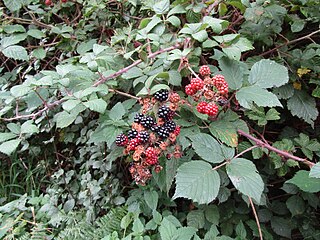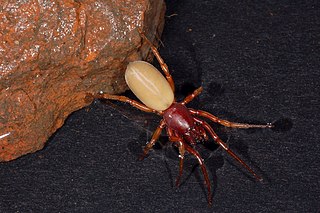
Rubus is a large and diverse genus of flowering plants in the rose family, Rosaceae, subfamily Rosoideae, with over 1,350 species, commonly known as brambles.

Mergus is the genus of the typical mergansers fish-eating ducks in the subfamily Anatinae. The genus name is a Latin word used by Pliny the Elder and other Roman authors to refer to an unspecified waterbird.

Dysderidae, also known as woodlouse hunters, sowbug-eating spiders, and cell spiders, is a family of araneomorph spiders first described by Carl Ludwig Koch in 1837. They are found primarily in Eurasia, extending into North Africa with very few species occurring in South America. Dysdera crocata is introduced into many regions of the world.

Begoniaceae is a family of flowering plants with two genera and about 2040 species occurring in the subtropics and tropics of both the New World and Old World. All but one of the species are in the genus Begonia. There have been many recent discoveries of species in the genus Begonia, such as Begonia truncatifolia which is endemic to San Vincente, Palawan. B. truncatifolia is smaller than other species of the genus Begonia and this new species is proposed Critically Endangered by standards set by the IUCN. The only other genus in the family, Hillebrandia, is endemic to the Hawaiian Islands and has a single species. Phylogenetic work supports Hillebrandia as the sister taxon to the rest of the family. The genus Symbegonia was reduced to a section of Begonia in 2003, as molecular phylogenies had shown it to be derived from within that genus. Members of the genus Begonia are well-known and popular houseplants.

The Travuniidae are a small family of harvestman with little more than ten described species, within the suborder Laniatores.

Austrozephyrus is a genus of butterflies in the family Lycaenidae. The three species are found in the Indomalayan realm.

Diplocynodon is an extinct genus of alligatoroid crocodilian that lived during the Paleocene to Middle Miocene in Europe. Some species may have reached lengths of 3 metres (9.8 ft), while others probably did not exceed 1 metre (3.3 ft). They are almost exclusively found in freshwater environments. The various species are thought to have been opportunistic aquatic predators.

Hypogastruridae is a family of springtails. Members of the family are common and widespread with a cosmopolitan distribution of about 660 species in about 40 genera.
Dendrolaelaps is a genus of mites in the family Digamasellidae. There are more than 170 described species in Dendrolaelaps.
Reicheadella is a genus in the ground beetle family Carabidae. There are about nine described species in Reicheadella, found in Europe.

Bebearia is a genus of brush-footed butterflies. The species are confined to the Afrotropical realm, mainly in the Guinean Forests of West Africa and the Congolian forests.

Histopona is a genus of funnel weavers first described as a sub-genus of Hadites by Tamerlan Thorell in 1870. It was elevated to genus by Brignoli in 1972.
Stygopholcus is a genus of Balkan cellar spiders that was first described by K. Absolon & J. Kratochvíl in 1932. As of June 2019 it contains only three species and one subspecies, found in Montenegro, Greece, Bosnia and Herzegovina, and Croatia: S. absoloni, S. photophilus, S. skotophilus, and S. s. montenegrinus.

Plutomurus ortobalaganensis is the deepest terrestrial animal ever found on Earth, living at 1,980 metres (6,500 ft) below a cave entrance. It is a species of springtail (arthropods) endemic to the Krubera-Voronja cave system in Abkhazia, Georgia. It was discovered in the CAVEX Team expedition of 2010. It feeds on a few fungi and decomposing organic matter in the caves.
Parastalita is a monotypic genus of Balkan woodlouse hunting spiders containing the single species, Parastalita stygia. It was first described by K. Absolon & J. Kratochvíl in 1932, and has only been found in Bosnia and Herzegovina. Notably, this species is blind as it completely lacks eyes.
Stalitella is a monotypic genus of Balkan woodlouse hunting spiders containing the single species, Stalitella noseki. It was first described by K. Absolon & J. Kratochvíl in 1932, and has only been found in Bosnia and Herzegovina and in Montenegro.

Deuteraphorura is a genus of springtails belonging to the family Onychiuridae. There are 83 species in the genus.

Proisotoma is a genus of elongate-bodied springtails in the family Isotomidae. There are at least 50 described species in Proisotoma.
Travunia is a genus of harvestman in the family Travuniidae. There are four described species in Travunia. They are found in caves in the southern Dinaric Karst region of Balkan Europe.

Protaphorura is a genus of arthropods belonging to the family Onychiuridae.













